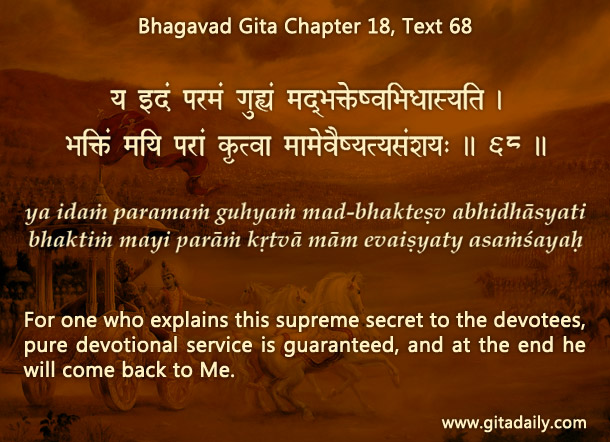If we approach spiritual life with material calculations, we frequently end up miscalculating things. For example, if we want to become wealthy, we accumulate wealth; we don’t distribute it. But if we want to become internally wealthy with spiritual realization, this rationale doesn’t apply – the more we share a realization, the more we secure it.
The Bhagavad-gita’s final chapter describes how this sharing-and-enriching applies to the highest realization of pure love. This chapter progresses from dutiful work (18.40) to pure devotion (18.54). When we are joyfully situated in spiritual self-understanding and are equipoised amidst worldly dualities, we attain pure devotion (para bhakti). This summit of spiritual realization is reached through the multi-stage, laborious process of becoming materially detached, seeking clearer understanding of spiritual reality and finally becoming attached to the supreme spiritual reality, Krishna.
In its concluding verses (18.68-71) that state the phala-shruti (the fruit of hearing), the Gita points to another, easier path for attaining pure devotion: the path of sharing the Gita’s message. The Gita’s last instructive words take us to the zenith of love, wherein Krishna bares his heart in a riveting declaration of love (18.64-65) and a disarming invitation to love (18.65-66).
Hearing this love-surcharged message inspires us to inform others about Krishna’s love in a mood of loving service to him. When we thus pave the way for others to enter Krishna’s world of love, we please him. And he magnanimously paves the way in our heart for the manifestation of that love which we have eagerly spoken about. Our savoring and sharing Krishna’s message works symbiotically to purify us and ultimately it catapults us to his abode of pure love (18.68).
Thus, the same pure devotion that comprises the summit of spiritual realization becomes mercifully accessible to those who share spiritual realization.

To know more about this verse, please click on the image
Explanation of article:
Podcast:

spiritual realization is attained by constant JAPA only